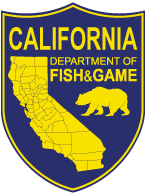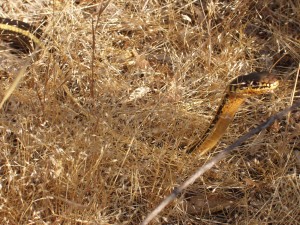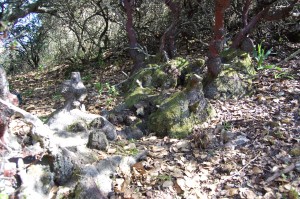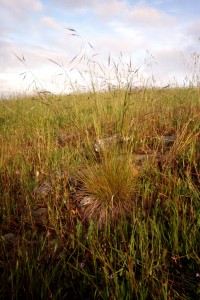Before the zoo’s expansion can be built, the zoo must apply for and receive a number of different permits from the state and federal regulatory agencies that are responsible for protecting sensitive natural resources in California. Over the next few weeks we’ll be discussing more specific details about the individual permits that must be obtained. We thought it would be useful to describe in general the role of the regulatory agencies at this stage of the development.
It’s important to remember that the forum of the regulatory agencies is different than the political arena of the City Council or the legal arena of the courtroom.
First, personnel from the regulatory agencies often make site visits. Staff from the US Fish and Wildlife Service and the California Department of Fish and Game toured Knowland Park with zoo representatives, consultants, and attorneys as well as other interested parties so that they were familiar with the project area and its natural resources. In these types of site visits, agency staff are able to evaluate claims made by various parties by seeing the habitat for themselves. If the development is controversial or being challenged, as in this case, they can weigh whether there are environmentally superior alternatives or whether proposed mitigations make sense in the real-world context of on-the-ground conditions. Agency staff can suggest changes to plans or projects and recommend additional avoidance, minimization, and mitigation measures.
Contrast this with the motivations and behavior of members of the City’s Planning Commission, City Council, and other city officials, some of whom never even visited Knowland Park– yet made broad, sweeping conclusions based solely on paper drawings, photographs, and statements made by the zoo. Yet another decisionmaker, Superior Court Judge Grillo, who heard the lawsuit, was free to tour the park on his own, but it would have been a breach of professional ethics for him to tour the park with either the petitioners (Friends of Knowland Park and the California Native Plant Society) or the respondents (zoo and city). He may also have never seen Knowland Park, but we will never know. The same will apply to the judges at the appellate court if we choose to appeal Judge Grillo’s decision.
California Department of Fish and Game

The California Department of Fish and Game is one of the major regulatory agencies that issues permits.
In this post we’ll look at the role of the California Department of Fish and Game (CDFG).
The mission of the CDFG is to manage California’s diverse wildlife and native plant resources, and the habitats upon which they depend, for their ecological values and for their use and enjoyment by the public. CDFG has jurisdiction over the conservation, protection, and management of wildlife, native plants, and habitat necessary to maintain biologically sustainable populations (Fish and Game Code §1802). As the trustee agency for fish and wildlife resources, the CDFG provides requisite biological expertise to make recommendations regarding those resources held in trust for the people of California (Fish and Game Code Section 1802).
CDFG plays several different roles in reviewing a development such as the zoo’s expansion project, depending upon the circumstances and the types of resources that it will impact.
CDFG’s Role under the California Endangered Species Act

The population of Alameda whipsnakes found at Knowland Park is protected by the California Endangered Species Act. Photo credit: David Gowen
The California Endangered Species Act (CESA) provides additional protections for such species, including “take” prohibitions (Fish and Game Code §2050 et seq.). Take is defined in Section 86 of the Fish and Game Code as “hunt, pursue, catch, capture, or kill, or attempt to hunt, pursue, catch, capture, or kill.”
As a responsible agency, CDFG has the authority to issue permits for the take of species listed under CESA if the take is incidental to an otherwise lawful activity; CDFG has determined that the impacts of the take have been minimized and fully mitigated; and, the take would not jeopardize the continued existence of the species (Fish and Game Code §2081).
Section 2080 of the Fish and Game Code prohibits “take” of any species that the commission determines to be an endangered species or a threatened species.
CESA emphasizes early consultation to avoid potential impacts to rare, endangered, and threatened species and to develop appropriate mitigation planning to offset project caused losses of listed species populations and their essential habitats.
Protecting Aquatic Resources
CDFG is responsible for conserving, protecting, and managing California’s fish, wildlife, and native plant resources. To meet this responsibility, the Fish and Game Code (Section 1602) requires an applicant to notify CDFG of any proposed activity that may substantially divert or obstruct the natural flow of any river, stream or lake or otherwise modify a river, stream, or lake. Accordingly, it has the authority to issue Streambed Alteration Agreement permits.
Protecting Native Plant Species
Some native plant species are protected by California law if they are deemed rare and threatened AND have gone through the lengthy and complex listing process. (To date, there are many plant species considered rare by botanists that have not yet been accorded protection because of a backlog in the listing process). Important California laws for native plant protection are the CESA, the Native Plant Protection Act (NPPA), the California Environmental Quality Act (CEQA), the Natural Community Conservation Planning Act (NCCPA), and the California Desert Native Plants Act (CDNPA).
In addition, the agency comments upon the environmental analysis documents for proposed projects under CEQA, the California Environmental Quality Act. The CDFG must be notified when CEQA projects involve fish and wildlife of the state, rare and endangered native plants, wildlife areas, and ecological reserves. Although the CDFG cannot approve or disapprove a whole project, lead and responsible agencies are required to consult with CDFG. If there are sensitive wildlife or native plant species or high priority plant communities that could suffer potential impacts from a project, CDFG must review the proposed project in order to determine whether to issue permits that would allow the project to proceed.
The CDFG takes on the role of a responsible agency when a lead agency requires a 1600 Streambed Alteration Agreement (SAA) or a 2081(b) CESA Incidental Take Permit for a project.
CDFG’s Role in Identifying and Protecting Rare Natural Communities
According to the CDFG website, “Natural Communities have been considered part of the Natural Heritage conservation triad, along with plant and animals of conservation significance, since the state inception of the Natural Heritage program in 1979…Since 1999, the Department of Fish and Game’s Vegetation Classification and Mapping Program has undertaken the classification and mapping of vegetation throughout the state and also has assumed the role of standardizing vegetation nomenclature for California to comply with the National Vegetation Classification System.”
CDFG maintains a list of natural plant communities which have been described, classified, and ranked in terms of how common or rare they are. High priority communities are those that are ranked S3, S2, or S1 and are considered rare and highly imperiled throughout their range. The rankings are based on an international methodology (see http://www.natureserve.org).
These designations support recommendations by CDFG for ways to avoid, minimize or mitigate impacts to rare communities. When a rare plant community is located, a record should be submitted to the California Natural Diversity Database of CDFG. In this way, valuable information is compiled.
CDFG Oversight of the Zoo’s Expansion Project
So, what role does CDFG play specifically with respect to the zoo’s proposed expansion project?
CDFG must determine whether to issue an Incidental Take Permit to the zoo for “taking” or killing Alameda whipsnakes as part of the project, since the Alameda whipsnake is classified as “threatened” under CESA, and a population of the snakes has been found on site. The category of threatened is defined as follows: a species is threatened when, although not presently threatened with extinction, it is likely to become an endangered species in the foreseeable future in the absence of special protection and management efforts.
CDFG must review the analysis provided by the zoo, analyze the likelihood of snakes being killed, and then determine if the impacts to Alameda whipsnake are minimized and fully mitigated, including how best to avoid impacts. When avoidance is not possible, the agency must then determine whether proposed mitigations are sufficient to offset the potential losses.
CDFG also oversees the issue of a Streambed Alteration Agreement (SAA) permit which would allow the Zoo to construct a new stormwater outfall into Arroyo Viejo Creek. The SAA also contains agreed upon measures to avoid, minimize, and mitigate impacts within the CDFG jurisdiction.

This very old Brittleleaf manzanita is an indicator species that defines the chaparral stand in Knowland Park as rare and imperiled maritime chaparral. Photo credit: Laura Baker
Finally, CDFG can comment upon and make recommendations to avoid impacts to the two high priority native plant communities present at the Zoo’s proposed expansion site: native grasslands (ranked S3 ) and maritime chaparral (ranked S2 or imperiled). [View our previous post on maritime chaparral here: Maritime Chaparral Post from 01_22_12 and our previous post on native grasslands here: Native Grasslands Post from 03_29_12] Both communities would suffer significant impacts from the proposed development. Consulting biologists or responsible agencies encountering high priority natural community elements or vegetation types when assessing a proposed project’s environmental impacts should make project proponents and reviewers aware of their existence. CDFG can determine whether the biological assessment submitted by the zoo as part of its permit application fully describes the project, the sensitive natural resources at the project site, and the impacts of the project to these resources in order to determine whether to issue permits, request more information, or deny the permit.
In summary, CDFG is a Trustee Agency, holding in trust for the public the fish, wildlife and plant resources of the state, including those in Knowland Park. In their role as trustees, they maintain the biological expertise to manage these resources. They are also a responsible agency when they must consider whether to issue an Incidental Take Permit to the zoo for killing Alameda whipsnakes as part of the project or whether to issue a Streambed Alteration Agreement permit for construction in Arroyo Viejo Creek. And finally, in its expert advisory role, CDFG may advise and recommend ways to avoid impacts to rare native plant communities on site, including the maritime chaparral and the native grasslands.
 Laura Baker is an environmental activist and former Conservation Chair of the California Native Plant Society. Growing up in Missouri, she learned that the cure for most ills rests in spending time out in nature. She wishes for every child to have the experience of wholeness that nature provides. Laura holds an M.A. in Ecology and Systematic Biology.
Laura Baker is an environmental activist and former Conservation Chair of the California Native Plant Society. Growing up in Missouri, she learned that the cure for most ills rests in spending time out in nature. She wishes for every child to have the experience of wholeness that nature provides. Laura holds an M.A. in Ecology and Systematic Biology.
Laura’s Knowlander blog is dedicated to building an online library of the natural history of Knowland Park so that the public may enjoy the park for the natural heritage treasure that it is. Knowing the land is a never ending process of inquiry open to all. We welcome your comments, contributions, and photos.

 Follow
Follow








Comments are closed.